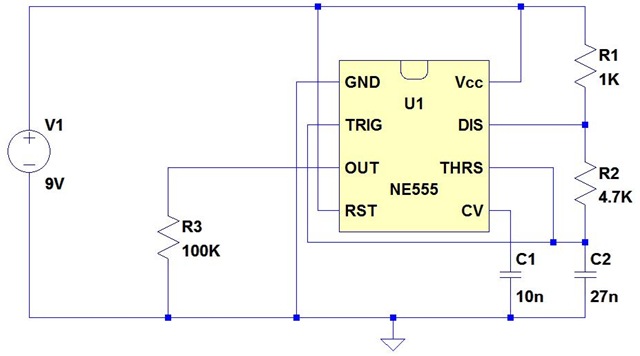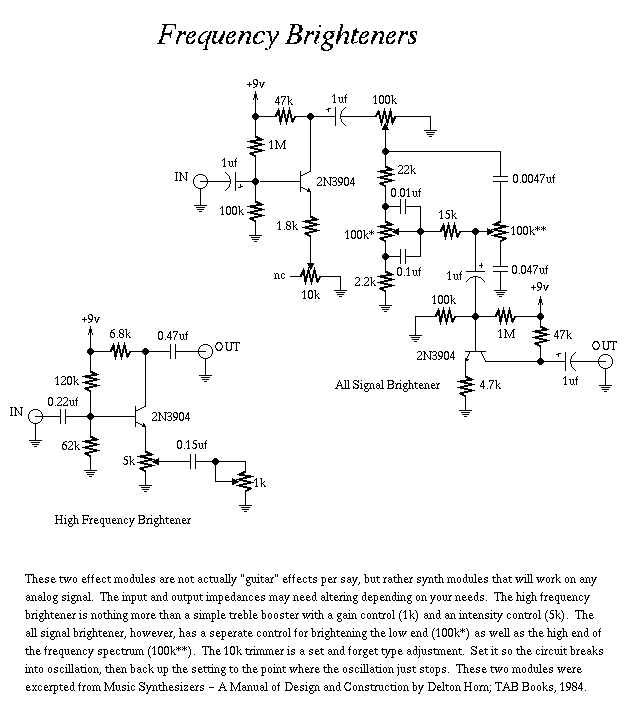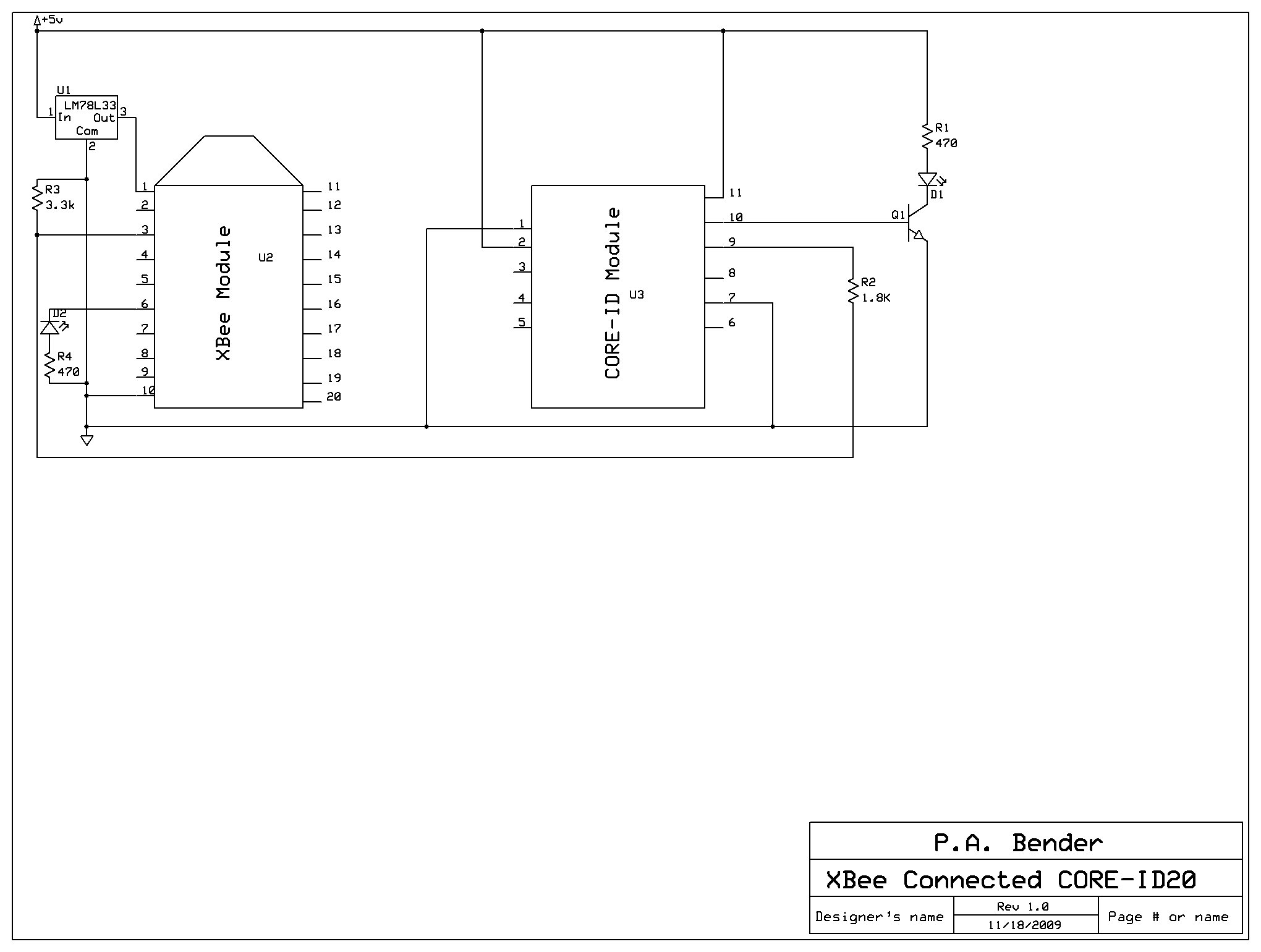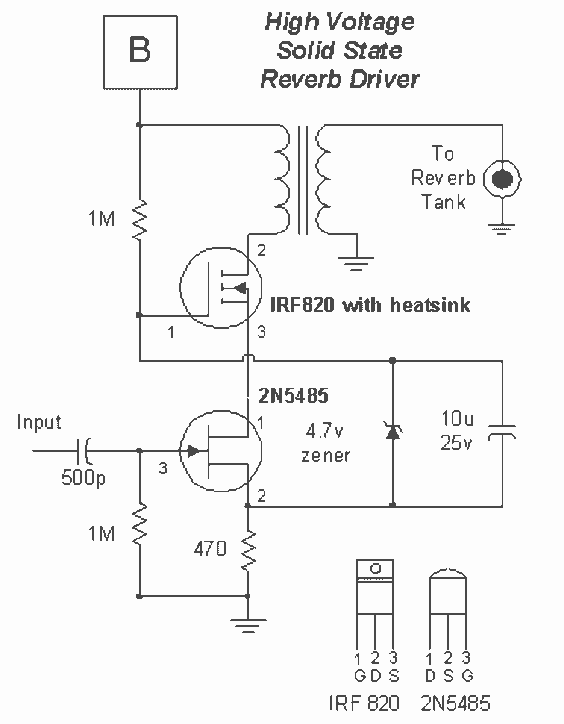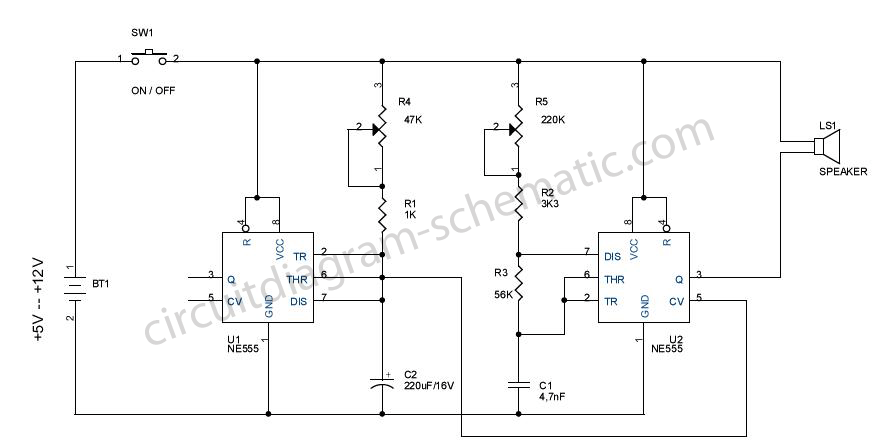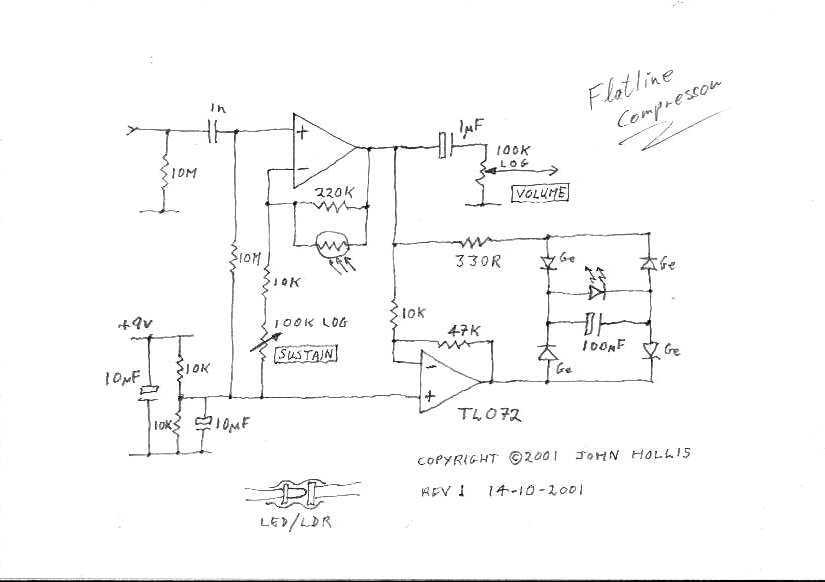
Guitar Stompbox & Effects Projects
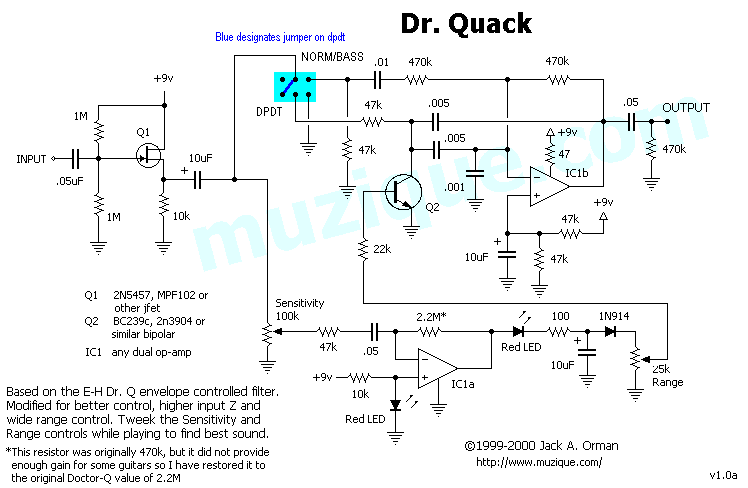
The classic Rangemaster is considered a source of some of the finest tones in rock guitar, from Clapton's Beano sound to Brian May's singing sustain tones. Although the effect is a simple one-transistor booster, finding a high-quality germanium transistor for building a Rangemaster clone can be challenging. Additionally, germanium transistors experience drift in bias and gain with temperature changes. By utilizing the basic Muffer circuit and adjusting a few component values, it is possible to create a simple booster that retains much of the Rangemaster's character while being more stable and made from readily available parts. This booster works best for overdriving the input of a tube amplifier or creating a bright, boosted response. The gain of the Muffer circuit has been reduced, and the input capacitor has been made smaller to achieve the desired frequency response. The Muffmaster can be constructed using the Muffer PCB layout with the pads for D1, D2, and C3 left empty, or it can be assembled on the AMZ Multi-Purpose PCB. Nearly any NPN silicon transistor can be used, including those specified for the Muffer. The low current draw ensures that the battery will have a long lifespan. While the response of silicon transistors under overload differs from that of germanium transistors, the resulting sound remains interesting and useful. This cost-effective booster offers significant value. The Fuzzface is a straightforward two-transistor design that produces the iconic sound of the 1960s. The original version utilized germanium transistors, but the manufacturer transitioned to silicon due to their availability and stability. The BC108 was used in the original 1973 circuit, but alternatives such as 2N5088, 2N5089, or 2N3904 may also be employed. C1 and C2 are aluminum electrolytics, while C3 can be mylar or a similar type. The Fuzz pot should be a linear taper, and the Volume pot should be an audio taper. Quarter-watt carbon film or metal film resistors are acceptable. A DPDT bypass switch may be integrated, as shown in the schematic. The two pots are mounted off the PCB and connected via short jumper wires. The ground should connect to the ground lug of either the input or output jack. The input is depicted as a stereo jack, allowing the effect to be activated when a plug is inserted by connecting the battery negative to the ring connection. A standard mono plug will ground the ring connection, completing the circuit from the battery negative to ground. A basic Fuzzface-type circuit has been modified to utilize a MOSFET transistor for Q2, resulting in a high-gain, over-the-top distortion. A Radio Shack 2N3904 (hfe=233) was used for Q1, although a silicon transistor with lower gain may yield better results. The input capacitor C1 significantly influences the sound; a value of 0.1uF may produce a darker tone, while 0.01uF may be too thin for certain instruments. Experimentation with capacitor values is recommended to find the optimal match for specific instruments and amplifiers. An audio taper pot is suggested for volume control, while a linear taper pot is recommended for the Fuzz control. This project can be built on the same PCB as the Fuzzface described previously, with the MOSFET's drain-gate-source leads connected to the corresponding collector-base-emitter pads. This variation of the widely used two-transistor distortion circuit has been updated and simplified, with complete schematics and PCB layouts available.
The Rangemaster circuit, known for its distinctive tonal qualities, primarily consists of a single transistor amplifier, typically a germanium type in its original form. However, modern adaptations utilize NPN silicon transistors to enhance reliability and availability. The circuit operates by amplifying the guitar signal, boosting its level to drive the input of a tube amplifier into overdrive, producing a warm and rich distortion characteristic of classic rock tones. The Muffer circuit serves as an effective alternative, allowing for adjustments in component values to tailor the frequency response and gain characteristics, thus emulating the Rangemaster’s tonal qualities while mitigating the temperature-related drift associated with germanium transistors.
The Fuzzface circuit, a staple in electric guitar effects, employs a straightforward two-transistor configuration that produces a heavily distorted sound. The choice of transistors, whether germanium or silicon, influences the tonal output, with silicon transistors providing greater stability and consistency. The design allows for easy modification, enabling builders to experiment with different capacitors and resistors to achieve desired sonic characteristics. The inclusion of bypass switches and pot configurations facilitates user control over the effect, making it versatile for various playing styles. Overall, these circuits exemplify the intersection of simplicity and musicality, offering musicians a pathway to explore and enhance their sound.The classic Rangemaster is thought to have been the source of some of the best tones in rock guitar, from Clapton`s Beano sound to some of Brian May`s singing sustain tones. While the effect is a simple one-transistor booster, locating a good quality germanium transistor to use in building a clone of the Rangemaster can be a problem.
Furthermore, germanium transistors will drift in bias and gain as the temperature of the transistor changes. If we use the basic Muffer circuit and tweak the values of a few of the components we can produce a simple booster that has a lot of the character of the Rangemaster while being more stable and built from easy to find parts. This booster is best used to overdrive the input of a tube amp or otherwise create a bright boosted response.
The gain of the Muffer circuit has been reduced and input capacitor made smaller to create the proper frequency response. The Muffmaster can be made using the Muffer pc board layout shown above with the pads for D1, D2 and C3 left empty, or it can be built on the AMZ Multi-Purpose PCB.
The transistor can be almost any NPN silicon device and the same devices listed for the Muffer may be used. The current draw is low and therefore the battery should last a long time. Because the response of silicon transistors to overload is different from that of germaniums, the sound will not be an exact duplicate of the classic effect but it is interesting and useful nonetheless.
This cheap booster provides a lot of bang for the bucks - try it out! The Fuzzface is a simple two transistor design that produces the classic sound of the `60s. The original version used germanium transistors but the manufacturer soon switched to silicon since they were more readily available and produced stable, repeatable results. The BC108 was used in my 1973 original circuit but 2N5088, 2N5089, 2N3904 or similar transistors may be used.
C1 and C2 are aluminum electrolytics and C3 may be mylar or similar. The Fuzz pot should be linear taper and the Volume audio taper. Quarter-watt carbon film or metal film resistors are acceptable. A dpdt bypass switch may be used as shown in the schematic of the project above. The two pots are mounted off the pc board and connected to it by short jumper wires. The ground should connect to the ground lug on either the input or output jack. The input is shown as a stereo jack since by connecting the battery negative to the ring connection, the effect may be switched on when a plug is inserted into the jack. A standard mono plug will ground the ring connection and make the circuit from the battery negative to ground to power up the device.
I took a basic Fuzzface-type circuit and modified the component values so that a mosfet transistor could be used for Q2. The result was a high gain over-the-top distortion. I used a Radio Shack 2N3904 (hfe=233) for Q1 but a silicon transistor with less gain might sound better.
The input capacitor C1 has a lot of effect on the sound. When I had it as 0. 1uF the sound was a little on the dark side, and 0. 01uF was too thin for my Strat. Experiment with the value of the capacitor to find one that works with your instrument and amp. Use an audio taper pot for the volume and a linear taper for the Fuzz control. This project can be built on the same pcb as the Fuzzface shown above. The mosfet would be dropped in with its d-g-s leads going to the c-b-e pads respectively. Check out this interesting variation of the frequently used two-transistor distortion. I decided to update and simplify some of the aspects of this popular distortion circuit that I had developed with Aron Nelson. Complete schematic and pcb layouts are provided. Check out the complete article on the smooth-sounding Shaka 5 Overdrive. I was looking through some patents related to solid-state emulation of the tube sound, and found the US Patent No.
5, 032, 796, which had been assigned to St. Louis Music. I woul 🔗 External reference
The Rangemaster circuit, known for its distinctive tonal qualities, primarily consists of a single transistor amplifier, typically a germanium type in its original form. However, modern adaptations utilize NPN silicon transistors to enhance reliability and availability. The circuit operates by amplifying the guitar signal, boosting its level to drive the input of a tube amplifier into overdrive, producing a warm and rich distortion characteristic of classic rock tones. The Muffer circuit serves as an effective alternative, allowing for adjustments in component values to tailor the frequency response and gain characteristics, thus emulating the Rangemaster’s tonal qualities while mitigating the temperature-related drift associated with germanium transistors.
The Fuzzface circuit, a staple in electric guitar effects, employs a straightforward two-transistor configuration that produces a heavily distorted sound. The choice of transistors, whether germanium or silicon, influences the tonal output, with silicon transistors providing greater stability and consistency. The design allows for easy modification, enabling builders to experiment with different capacitors and resistors to achieve desired sonic characteristics. The inclusion of bypass switches and pot configurations facilitates user control over the effect, making it versatile for various playing styles. Overall, these circuits exemplify the intersection of simplicity and musicality, offering musicians a pathway to explore and enhance their sound.The classic Rangemaster is thought to have been the source of some of the best tones in rock guitar, from Clapton`s Beano sound to some of Brian May`s singing sustain tones. While the effect is a simple one-transistor booster, locating a good quality germanium transistor to use in building a clone of the Rangemaster can be a problem.
Furthermore, germanium transistors will drift in bias and gain as the temperature of the transistor changes. If we use the basic Muffer circuit and tweak the values of a few of the components we can produce a simple booster that has a lot of the character of the Rangemaster while being more stable and built from easy to find parts. This booster is best used to overdrive the input of a tube amp or otherwise create a bright boosted response.
The gain of the Muffer circuit has been reduced and input capacitor made smaller to create the proper frequency response. The Muffmaster can be made using the Muffer pc board layout shown above with the pads for D1, D2 and C3 left empty, or it can be built on the AMZ Multi-Purpose PCB.
The transistor can be almost any NPN silicon device and the same devices listed for the Muffer may be used. The current draw is low and therefore the battery should last a long time. Because the response of silicon transistors to overload is different from that of germaniums, the sound will not be an exact duplicate of the classic effect but it is interesting and useful nonetheless.
This cheap booster provides a lot of bang for the bucks - try it out! The Fuzzface is a simple two transistor design that produces the classic sound of the `60s. The original version used germanium transistors but the manufacturer soon switched to silicon since they were more readily available and produced stable, repeatable results. The BC108 was used in my 1973 original circuit but 2N5088, 2N5089, 2N3904 or similar transistors may be used.
C1 and C2 are aluminum electrolytics and C3 may be mylar or similar. The Fuzz pot should be linear taper and the Volume audio taper. Quarter-watt carbon film or metal film resistors are acceptable. A dpdt bypass switch may be used as shown in the schematic of the project above. The two pots are mounted off the pc board and connected to it by short jumper wires. The ground should connect to the ground lug on either the input or output jack. The input is shown as a stereo jack since by connecting the battery negative to the ring connection, the effect may be switched on when a plug is inserted into the jack. A standard mono plug will ground the ring connection and make the circuit from the battery negative to ground to power up the device.
I took a basic Fuzzface-type circuit and modified the component values so that a mosfet transistor could be used for Q2. The result was a high gain over-the-top distortion. I used a Radio Shack 2N3904 (hfe=233) for Q1 but a silicon transistor with less gain might sound better.
The input capacitor C1 has a lot of effect on the sound. When I had it as 0. 1uF the sound was a little on the dark side, and 0. 01uF was too thin for my Strat. Experiment with the value of the capacitor to find one that works with your instrument and amp. Use an audio taper pot for the volume and a linear taper for the Fuzz control. This project can be built on the same pcb as the Fuzzface shown above. The mosfet would be dropped in with its d-g-s leads going to the c-b-e pads respectively. Check out this interesting variation of the frequently used two-transistor distortion. I decided to update and simplify some of the aspects of this popular distortion circuit that I had developed with Aron Nelson. Complete schematic and pcb layouts are provided. Check out the complete article on the smooth-sounding Shaka 5 Overdrive. I was looking through some patents related to solid-state emulation of the tube sound, and found the US Patent No.
5, 032, 796, which had been assigned to St. Louis Music. I woul 🔗 External reference
